Growth & its Phases, Rates, Conditions, Processes | Biology Class 11 - NEET PDF Download
When we talk about growth, we are talking about a remarkable journey of change. Imagine a tiny seedling emerging from the soil, pushing its way upwards to become a towering tree, spreading its branches and leaves towards the sky.
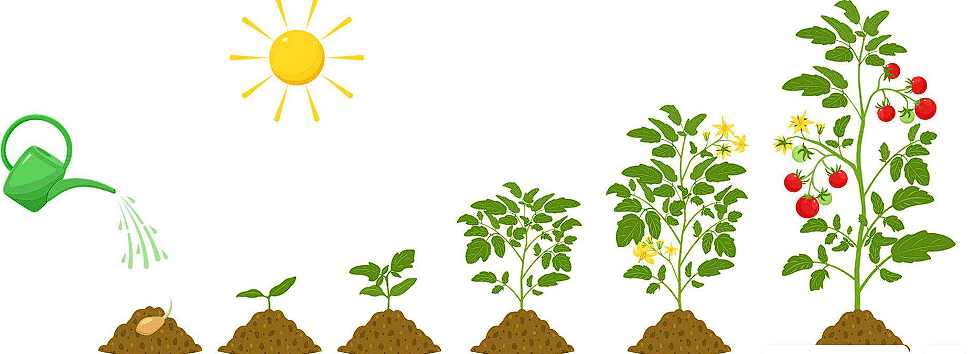 Growth
Growth
What is Growth and Development in Plants?
"Growth" is a fundamental biological process that refers to an increase in size, mass, and complexity of an organism over time by becoming more differentiated. Growth can occur in various biological life forms including plants, animals, and microorganisms".
Differentiation refers to the process by which unspecialized or undifferentiated plant cells develop into specialized cell types with distinct structures and functions. This is a fundamental aspect of plant development and growth.
"Development" is sum of growth and differentiation. development process leads to the formation of a complex body organization in plants, including structures like roots, leaves, branches, flowers, fruits, and seeds.
Example: Seed germination
- Seed germination is the initial step in the plant growth process.
- Seeds germinate only under favorable environmental conditions that support growth.
- When these favorable conditions are not present, seeds enter a dormant stage.
- Once the favorable conditions return, seeds become metabolically active again, and the process of growth resumes.
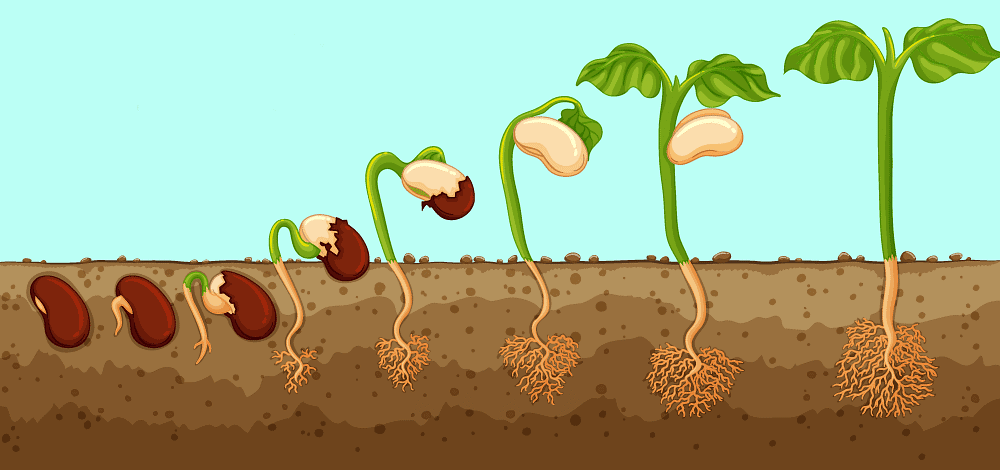 Seed Germination
Seed Germination
Characteristics of Growth
(i) Plant Growth Generally is Indeterminate
- Plant growth is characterized by continual expansion throughout its lifespan.
- Specialized regions called meristems exist in specific locations within the plant's structure.
- Meristematic cells within these regions can undergo division and self-renewal.
- As meristematic cells differentiate, they lose their ability to divide and become integral parts of the plant's structure.
- This mode of growth, where new cells are consistently added through meristematic activity, is termed "open growth."
- Meristems primarily contribute to the lengthening of the plant along its central axis.
- In dicotyledonous plants and gymnosperms, additional types of meristems, such as the vascular cambium and cork cambium, become active at a later stage in the plant's life cycle.
- These lateral meristems are responsible for increasing the thickness or girth of the plant's organs, known as "secondary growth."
 Locations of Root, Shoot and Vascular Cambium
Locations of Root, Shoot and Vascular Cambium
(ii) Growth is Measurable
- Cellular growth in plants is primarily a result of an increase in protoplasm.
- Directly measuring protoplasmic increase is challenging, so scientists use various parameters to assess growth.
- Parameters used to measure growth include increase in fresh weight, dry weight, length, area, volume, and cell number.
- Different plant structures may require different parameters for measurement.
(a) Length is often used for structures like roots and pollen tubes.
(b) Area is relevant for dorsiventral (flattened) leaves.
(c) Volume measurement is less common but applicable for certain structures.
(d) Cell number can be used to assess growth in terms of cell division. - The choice of measurement parameter depends on the specific plant structure and research objectives.
- Growth can be expressed differently; for example, some plants emphasize an increase in cell size, while others focus on cell number.
- These measurements are essential for plant science research, agricultural applications, and understanding plant development and physiology.
Phases Of Growth
The term "Phases of growth" refers to a concept that is often used to describe the process of development and maturation in various organisms or systems. It signifies that growth is not a continuous or uniform process but occurs in distinct stages or phases, each of which is marked by specific and characteristic changes. These changes can be related to various aspects, including physiology, structure, and function.
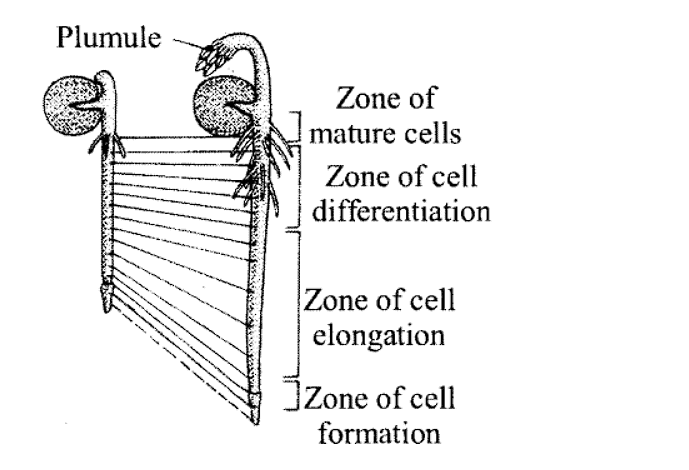 Phases of Growth
Phases of Growth
The period of growth in plants is generally divided into three phases:
(a) Meristematic Phase:
- This is the initial phase of growth, where cells are constantly dividing. Both the root apex (bottom part of the root) and the shoot apex (top part of the stem) contain meristematic cells. These cells are rich in protoplasm and possess large, conspicuous nuclei.
- Their cell walls are primary in nature, thin, and cellulosic, with abundant plasmodesmatal connections. This phase is primarily responsible for increasing the number of cells and building the plant's basic structure.
(b) Elongation Phase:
- Cells in the region proximal (just next, away from the tip) to the meristematic zone represent the phase of elongation.
- During this phase, cells undergo significant changes, including increased vacuolation (formation of vacuoles), cell enlargement, and the deposition of new cell walls.
- These changes result in the elongation of the plant's organs, such as roots and shoots.
(c) Maturation Phase:
- Further away from the apex, i.e., more proximal to the phase of elongation, lies the portion of the plant axis that is undergoing the phase of maturation.
- In this phase, cells attain their maximal size in terms of wall thickening and protoplasmic modifications.
- Growth RateThis phase is responsible for the development of specialized tissues and cell types. Most of the tissues and cell types studied in earlier classes, such as xylem and phloem, represent this phase of growth.
Growth Rates
Growth rate refers to the increased growth per unit time and can be expressed mathematically. Growth can be arithmetic or geometrical, depending on how cells are produced.
 Diagrammatic representation of : (a) Arithmetic (b) Geometric growth and (c) Stages during embryo development showing geometric and arithematic phases
Diagrammatic representation of : (a) Arithmetic (b) Geometric growth and (c) Stages during embryo development showing geometric and arithematic phases
(i) Arithmetic Growth
- In arithmetic growth, after mitotic cell division, only one daughter cell continues to divide while the other differentiates and matures.
- A simple example of arithmetic growth is a root elongating at a constant rate.
- When plotting the length of the organ against time, a linear curve is obtained.
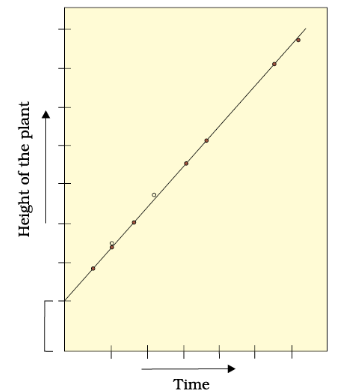 Arithmetic Growth Graphical Representation
Arithmetic Growth Graphical Representation
Mathematically, it is expressed as
Lt = L0 + rt
Lt = length at time ‘t’
L0 = length at time ‘zero’
r = growth rate / elongation per unit time.
(ii) Geometric Growth
- Geometrical growth begins with a lag phase followed by rapid increase at an exponential rate (log or exponential phase).
- During this phase, both progeny cells retain the ability to divide after mitotic cell division.
- However, with limited nutrient supply, growth slows down leading to a stationary phase.
- When plotting growth parameters against time, a typical sigmoid or S-curve is obtained.
- The sigmoid curve is characteristic of living organisms growing in a natural environment and is typical for all cells, tissues, and organs of a plant.
 Geometric Growth Graphical RepresentationThe exponential growth can be expressed as
Geometric Growth Graphical RepresentationThe exponential growth can be expressed as
W1 = W0 ert
W1 = final size (weight, height, number etc.)
W0 = initial size at the beginning of the period
r = growth rate
t = time of growth
e = base of natural logarithms
Quantitative Comparison of Growth
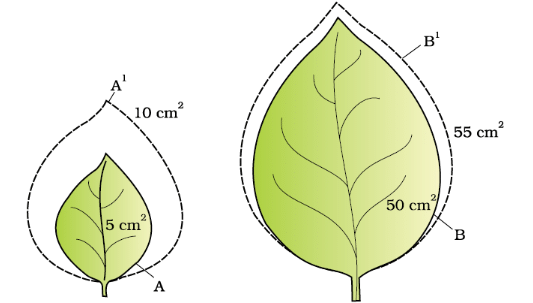 Diagrammatic comparison of absolute and relative growth rates. Both leaves A and B have increased their area by 5 cm2 in a given time to produce A1 , B1 leaves.
Diagrammatic comparison of absolute and relative growth rates. Both leaves A and B have increased their area by 5 cm2 in a given time to produce A1 , B1 leaves.
- Absolute Growth Rate: This refers to the total growth of a living system per unit time. It involves measuring and comparing the total growth without any specific basis for comparison, such as the initial size or mass.
- Relative Growth Rate: This measures the growth of a system per unit time, but expresses it on a common basis, such as per unit of the initial parameter (e.g., per unit initial size or mass). It provides a way to compare growth rates relative to the starting point.
Conditions for Growth
- Water: Water is crucial for plant growth as it is needed for cell enlargement, which is a key part of how plant cells grow in size. Turgidity, or the fullness of plant cells with water, is essential for extension growth. Additionally, water provides the medium for enzymatic activities that are necessary for growth.
- Oxygen: Oxygen is important for releasing metabolic energy, which is essential for various growth activities in plants.
- Nutrients: Plants require both macro and micro nutrients for the synthesis of protoplasm and as a source of energy. These nutrients are vital for various metabolic processes and overall growth.
- Optimum Temperature: Every plant has a specific temperature range that is best suited for its growth. Deviation from this range can be harmful to the plant's survival.
- Environmental Signals: Factors such as light and gravity also influence certain phases or stages of plant growth. For example, light is crucial for photosynthesis and other growth processes, while gravity helps in orienting plant growth.
Differentiation, Dedifferentiation and Redifferentiation
- Differentiation: This is the process where cells from the root apical, shoot-apical meristems, and cambium develop to take on specific roles. During differentiation, cells change their structure, particularly in their cell walls and protoplasm. For example, to create a tracheary element, cells lose their protoplasm and form strong, flexible, lignocellulosic secondary cell walls to move water over long distances under pressure.
- Dedifferentiation: This is a fascinating process where cells that have already specialized and can no longer divide regain the ability to do so under certain conditions. This leads to the creation of new meristems, like interfascicular cambium and cork cambium, from fully specialized parenchyma cells.
- Redifferentiation: After dedifferentiation, the new meristems or tissues can divide and create cells that again lose their ability to divide but mature to carry out specific functions. This process is known as redifferentiation. Examples of redifferentiation in woody dicot plants include: Heartwood and sapwood in trees, Cork cambium producing cork and Pith parenchyma cells changing into sclereids.
- Tumors in Plants: Tumors in plants are unusual growths of tissue caused by various factors such as injury, infection, or genetic changes. These are areas where cell division occurs uncontrollably.
- Parenchyma Cells in Plant Tissue Culture: In plant tissue culture, parenchyma cells that are encouraged to divide in controlled lab settings are referred to as callus. Callus formation is a crucial step in plant tissue culture because it provides a source of undifferentiated cells that can be prompted to develop into shoots, roots, or whole plants.
- Open Differentiation in Plants: Just as plant growth is open, so is differentiation. Cells and tissues that come from the same meristem can develop different structures when they mature, depending on their position. For instance, cells farther from root apical meristems differentiate into root-cap cells, while those that move to the outside mature into epidermis.
|
169 videos|525 docs|136 tests
|
FAQs on Growth & its Phases, Rates, Conditions, Processes - Biology Class 11 - NEET
| 1. What is the difference between growth and development in plants? |  |
| 2. What are the characteristics of plant growth? |  |
| 3. What are the phases of plant growth? |  |
| 4. How is growth rate calculated in plants? |  |
| 5. What is a growth curve in plants? |  |

















